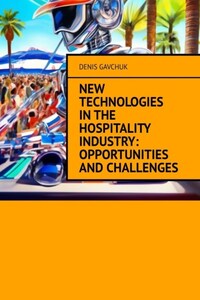The current state of the hospitality industry is characterized by dynamic development and adaptation to changes in consumer preferences. The hospitality industry, covering segments such as hotel business, restaurant services, travel services and entertainment events, is showing steady growth. According to the World Tourism and Travel Council, the sector’s contribution to the global economy was $ 8.9 trillion in 2022, demonstrating its importance and potential for further growth.
In today’s world, technology plays a key role in transforming the hospitality industry. Their importance cannot be overemphasized: new technical solutions not only improve the quality of customer service, but also optimize operational processes, reduce costs and increase the competitiveness of companies. The use of technologies such as artificial intelligence, the Internet of Things, and blockchain opens up new horizons for businesses and increases customer satisfaction. For example, the use of artificial intelligence-based chatbots for booking rooms and processing guest requests can significantly reduce response time and increase the efficiency of customer interaction.
The main purposeof this book is to analyze the application of innovative technologies in the hospitality industry, as well as to consider the challenges and opportunities that arise in this process. The objectives of the study include reviewing current technologies, assessing their impact on the quality of services provided and operational processes, as well as identifying key problems and potential risks associated with their implementation. In addition, this study aims to offer recommendations for the successful integration of new technologies into the business model of companies operating in this industry.
The research methodology is based on a comprehensive analysis of the existing literature, data from which will be supplemented by the results of interviews with experts and industry representatives. Both quantitative and qualitative approaches will be used in the work: quantitative data will allow an objective assessment of the impact of technologies on production indicators, while qualitative data obtained during interviews will provide a deeper understanding of current trends and practical aspects of their implementation. Such a multi-faceted approach will provide a comprehensive coverage of the topic and allow us to offer sound conclusions and recommendations.
Chapter 1: Introducing Robots to Hospitality
History and examples of using robots in hotels and restaurants
The use of robots in the hospitality industry is one of the brightest areas of technological evolution that can significantly change the face of the industry. Interest in robotization in the hotel and restaurant business was already evident in the middle of the 20th century, however, ensuring real implementation became possible only with the development of modern automation and artificial intelligence. At the turn of the new millennium, some initiatives to introduce automated solutions became experiments. One of the first examples is theHenn-na Hotel, which opened in Japan in 2015. This hotel became known as the first in the world to be operated by robots, which attracted many visitors and media attention. The hotel employed more than 30 robots performing various tasks, from checking in to delivering luggage to rooms, which significantly reduced staff costs and increased the level of automation. Another important stage in the history of the use of robots in hospitality was the activitySaviokeof the Savioke Corporation, which specializes in the development of delivery robots for hotels. In 2016, one of their projects, the Relay robot, started working inthe Aloft hotel chain, owned by Marriott International, and quickly gained popularity among guests, who were impressed by the possibility of receiving services at a high technological level.Relay robotsdelivered items such as drinks, toiletries and even documents to guests ' rooms, which made it possible to relieve staff and optimize operational processes.
Restaurants have also been affected by the introduction of robotics. In 2018, the automated pizzeria «Zume Pizza» in California began using robots for pizza preparation, which allowed to increase productivity and reduce the cost of production. In 2020, the Spyce restaurant chainin Boston demonstrated robot chefs capable of preparing various dishes independently, observing high standards of quality and hygiene. These examples show the industry’s high willingness to adapt to new technologies. Analyzing the current trends, it is worth noting that the introduction of robots in the hotel and restaurant industry is associated not only with technical, but also with social challenges. A 2021 McKinsey survey found that 30% of customers in the United States and Europe are positive about automating the service process, but 20% expressed concern about job losses and lack of human interaction. However, technology will continue to evolve, and the integration of robots into the hospitality sector will become an increasingly integral part of business processes.








